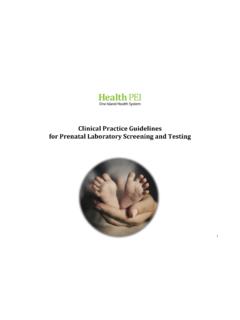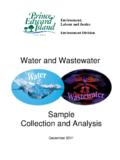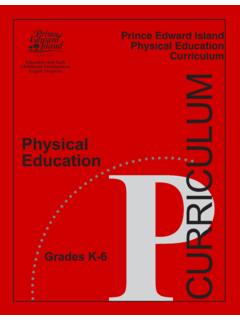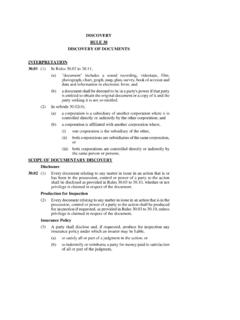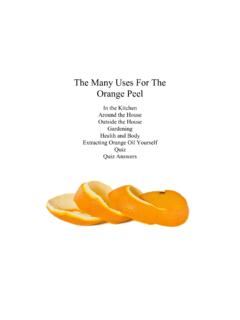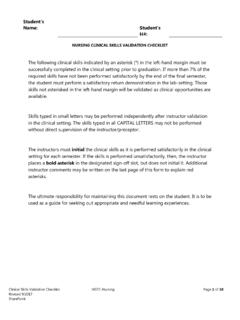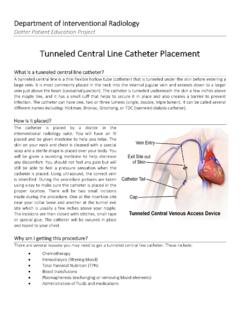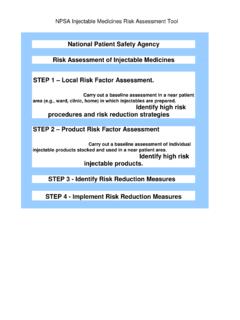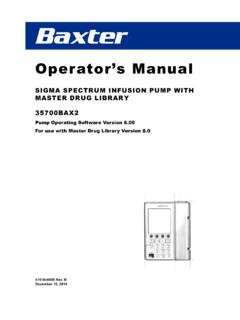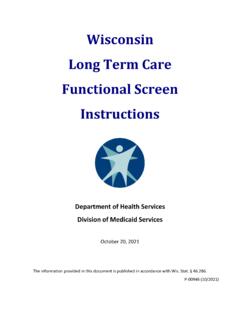Transcription of Medical Surgical Nursing Skills List
1 1 Medical Surgical Nursing Skills List Read each of the required clinical Skills for a Registered Nurse working on a typical acute Medical - Surgical unit. Write the number that corresponds to the level of experience you have had with the specific skill. For example, under I. Assessment - A. Measure patient s vital signs, if you had taken a patient s vital signs on your own (independently) in your previous Nursing job then you would put a 4 beside this skill and all the other Skills you had performed on your own. Performance Code: 1 = I have no experience with this skill 2 = I have performed this skill with assistance 3 = I have performed this skill under supervision 4 = I have performed this skill independently Competency Self-Assessment 1.
2 ASSESSMENT: Performance Code Measure patient s vital signs: TPR Blood pressure- manual and machine Neurological checks (orientation to time, place, person; response to directions and painful stimuli, pupillary reaction, extremity movement) Height Weight : Performance Code Write initial plan of care Nursing diagnosis/need/focus/discharge planning and patient teaching needs. Establish goals with patient/family/SO. Write Nursing interventions. 3. IMPLEMENTATION: Performance Code a. Maintain Respiratory Function: 1. administration of oxygen- set up, initiate and administer: Nasal cannula Face mask Venti mask Nonrebreathing mask Trach collar 2 T-piece 2.
3 Incentive spirometry- demonstrate use of 3. Coughing and deep breathing - demonstrate and work with patient. 4. Suctioning - lubricate catheter if applicable, insert, suction, and withdraw: Nasotracheal Oropharyngeal. Nasopharyngeal 5. Tracheotomy care - perform tube care, clean wound, change dressing, document. 6. Closed chest drainage - observe for leaks, maintain, measure output, assess and document respiratory status, assess dressing: Gravity Suction 7. Pulse oximeter - set up, apply sensor, set alarms, reassure, interpret, record.
4 8. Suction equipment - set up and maintain: Portable suction 9. Respiratory assist devices - set up and maintain: CPAP for sleep apnea BIPAP 10. Ventilator management identify FIO2, rate, TV mode. Respond, reset, and interpret alarms. Check humidification source and vent temperature. Empty excess water from tubing and administer nebulized medication. 3 3. IMPLEMENTATION: Performance Code b. Maintain Cardiovascular Function: 1. Code management: Verbalize emergency number to call. Initiate and administer BCLS. Bring code cart and EKG machine Attach oxygen to Bag-Valve-Mask resuscitator.
5 Prepare code medications 2. Code cart and equipment maintenance - check cart, check oxygen tank, check suction, and EKG machine 3. Blood products: Check, administer, and document blood product administration Monitor patient during administration State policy/procedure to use with transfusion reaction c. Support and Maintain Nutritional Requirements: , PPN, intra-lipids administer and document 2. Tube feeding - check for placement, administer feedings, check and record residual: Nasogastric Gastrostomy Jejunostomy 3. Intravenous therapy (peripheral, intermittent infusion devices): Verify order Insert line/device and label dressing Label bag and tubing Calculate and regulate rate Flush intermittent infusion device Assess and document site condition 4.
6 Central line/Peripherally inserted central line (PICC) catheter care: Assess, change dressing, document site condition 3. IMPLEMENTATION: Performance Code c. Support and Maintain Nutritional Requirements: (cont d) Access central venous access catheter with subcutaneous reservoir Flush/heparinize as per policy/procedure or as ordered by MD 4 d. Administer Medications: 1. Oral 2. Nasogastric 3. Subcutaneous 4. Intramuscular 5. Intravenous via peripheral line, intermittent infusion device, central line 6. Rectal 7.
7 Vaginal 8. Ophthalmi 9. Otic 10. Topical 11. Patient Controlled Analgesia (PCA) 12. Nebulization 13. Metered Dose Inhaler (MDI) with inhaler e. Care for the Patient with Limited Mobility: 1. Pressure ulcer management - assess risk factors, document stage/observation, initiate and maintain skin care protocol 2. Range of motion exercises - initiate and maintain skin care protocol 3. Preventive positioning and turning 4. Transfer to chair 5. Transfer to stretcher 6. Ambulation: With assistance Cane Crutches Walker 7.
8 Care of patient with immobilizing device: Cast Traction Sling 3. IMPLEMENTATION: Performance Code f. Maintain Elimination Function of GI and GU Systems: 1. Care of the patient with naso-gastric tube - check for placement and patency, maintain suction, check bowel sounds, perform nasal care, and document 2. Enemas: Fleets Retention Care: 5 Skin care Observation of stoma. Application of appliance. Irrigation (with cone only), if applicable 4. Catheterization - insert, maintain, record output, provide perineal care, remove 5.
9 Suprapubic catheter care 6. External catheter care (condom) 7. Peritoneal dialysis: Initiate peritoneal dialysis Add medications Perform solution exchange Obtain dialysate culture and cell count Perform catheter and exit site care Terminate peritoneal dialysis g. Collect Specimens: 1. Stool for occult blood 2. Urine for urinalysis 3. Urine for culture and sensitivity: Indwelling Clean catch 4. 24-hour urine collection 5. Urine for S & A 6. Wound for C & S 7. Sputum for C & S 8. Sputum for AFB 9. Blood glucose monitoring 6 3.
10 IMPLEMENTATION: Performance Code h. Implement Principles of Infection Control (routine practices): 1. Hand washing 2. Isolation protocols 3. Universal precautions 4. Sterile dressing changes 5. Gowning, gloving, masking 6. Disposal of contaminated linen/trash 7. Handling of reusable equipment 8. Use of particulate respirators i. Maintain Patient, Visitor, Staff Safety, Environmental Safety: 1. Falls prevention - identify patient at risk, initiate and maintain patient safety alert protocol. 2. Restraints - identify need, assess, and provide comfort measures, renew order, document 3.

